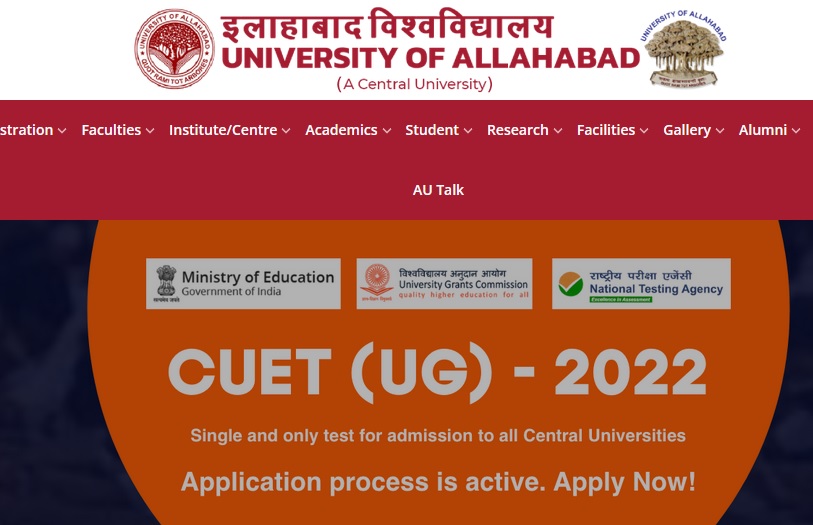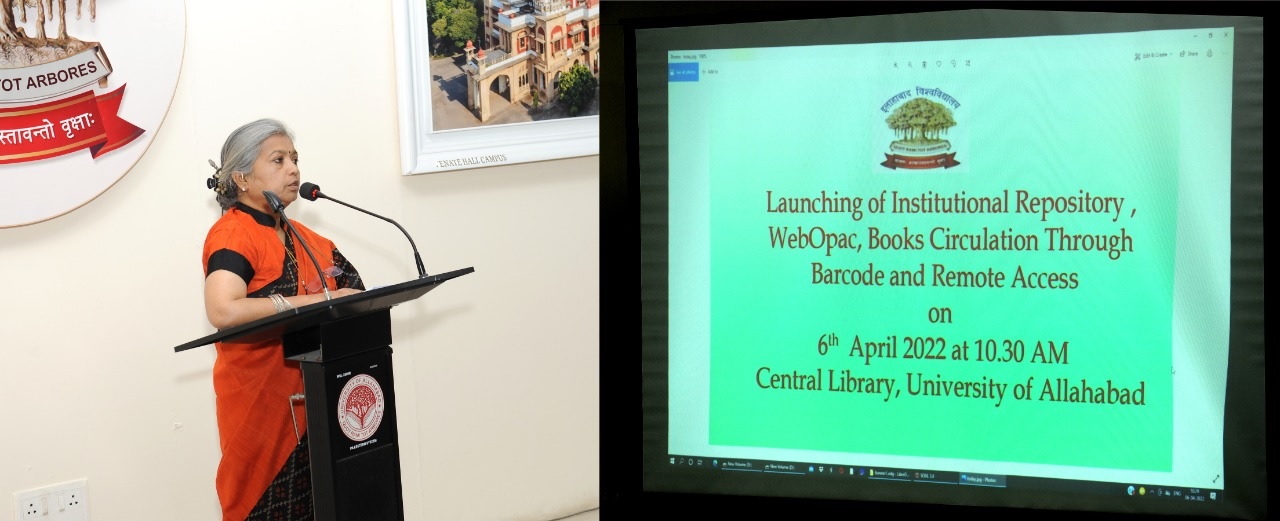Allahabad University Admission Examination Syllabus 2022-23 : allduniv.ac.in
Organisation : Central University of Allahabad, Prayagraj (U.P.)
Exam Name : Allahabad University Admission Examination 2022-23
Course : UG, PG and PG Diploma courses
Announcement : Allahabad University Admission Examination Syllabus 2022-23
Admit Card Date : 26th July 2022
Exam Date : 02-07 August 2022
Website : https://allduniv.ac.in/
What is AU Admission Exam?
Allahabad University Admission Examination, students are required to take CUET, PGAT or CRET entrance exam for UG, PG and PhD courses, respectively. The Under-Graduate and Post-Graduate degree courses are Regular and fulltime courses and the students shall not be permitted to join any other course with it. The students whose attendance in the prescribed subjects of Study, Seminar, Classes and Computer training or any other course prescribed in the semester falls short of the required 75% shall not be allowed to appear at the examinations.

Syllabus for AU Entrance Test
The Syllabus for AU Entrance Test are given below,
Bachelor of Computer Applications (BCA)
• Five Year Integrated BCA & MCA (Data Science)
• B. Voc. Degree Programme in Software Development
The questions in this paper will cover: Logical Reasoning, Quantitative Reasoning, Intermediate level Mathematics, Vocabulary, Intermediate level Computer Awareness, English Comprehension and Verbal Ability.
1. General English:
Questions in this section will be designed to test the candidates’ general understanding of the English language.
There will be questions on the following topics: Comprehension, Vocabulary, Basic English Grammar (like usage of correct forms of verbs, prepositions and articles), Word power, Synonyms and Antonyms, Meanings of words and phrases, Technical writing.
2. Analytical Ability, Logical Reasoning, General Knowledge and General Science General Aptitude:
The main objective of this section is to assess the General Aptitude of the candidate to pursue Computer Application and Software Profession.
3. Mathematics:
Algebra: Fundamental Operations in Algebra, Expansion, Factorization, Quadratic Equations, Indices, Logarithms, Arithmetic, Geometric and Harmonic Progressions, Binomial Theorem, Permutations and Combinations;
Probability and Statistics : Basic concepts of Probability Theory, Averages, Frequency Distributions, and Measures of Dispersions and Skewness Binomial, Poisson, Normal Distributions, Curve Fitting, and Principle of Least Squares, Correlation and Regression.
Arithmetic: Ratios and Proportions, Problems on Time-Work, Distance-Speed, Percentage.
Basic Set Theory and Functions: Set, Relations and Mappings.
Mensuration: Areas, Triangles and Quadrilaterals, Area and Circumference of Circles, Volumes and Surface Areas of Simple Solids such as Cubes, Spheres, Cylinders and Cones.
Limits, Continuity and Differentiability, Differentiation, Application of Derivatives, Indefinite and Definite Integration, Differential Equations, Co-ordinates and Straight Lines, Circles, Conic Sections, Complex Numbers, Sequences and Series, Exponential and logarithmic Series, Determinants and Matrices.
4. Computer Awareness:
Computer Basics: Organization of a Computer, Central Processing Unit (CPU), Structure of Instructions in CPU, Input / Output Devices, Computer Memory, Memory Organization, Back-up Devices. Operating System.
Data Representation: Representation of Characters, Integers and Fractions, Binary and Hexadecimal representations,
Binary Arithmetic: Addition, Subtraction, Division, and Multiplication.
Logic Algebra: Boolean Algebra, Theorems, Switching Functions, Disjunctive and Conjunctive, Canonical forms of switching functions, Combinational and Sequential Circuits.
Computer Architecture: Block Structure of Computers, Communication between Processor and I/O Devices, Interrupts.
Computer Language: Algorithms, Flow Chart, Control Structures, Design of Algorithm, Concepts of Low Level, Intermediate Level and High Level Language Programming in ‘C’.
Master in Computer Applications (MCA)
The questions in this paper will cover: Logical Reasoning, Quantitative Reasoning, Intermediate level Mathematics, Vocabulary, Computer Awareness, English Comprehension and Verbal Ability
1. General English:
Questions in this section will be designed to test the candidates’ general understanding of the English language. There will be questions on the following topics: Comprehension, Vocabulary, Basic English Grammar (like usage of correct forms of verbs, prepositions and articles), Word power, Synonyms and Antonyms, Meanings of words and phrases, Technical writing.
2. Analytical Ability, Logical Reasoning, General Knowledge and General Science:
General Aptitude: The main objective of this section is to assess the general aptitude of the candidate to pursue computer application and software profession.
3. Mathematics:
Algebra: Fundamental Operations in Algebra, Expansion, Factorization, Quadratic Equations, Indices, Logarithms, Arithmetic, Geometric and Harmonic Progressions, Binomial Theorem, Permutations and Combinations;
Probability and Statistics : Basic concepts of Probability Theory, Averages, Frequency Distributions, and Measures of Dispersions and Skewness Binomial, Poisson, Normal Distributions, Curve Fitting, and Principle of Least Squares, Correlation and Regression.
Arithmetic: Ratios and Proportions, Problems on Time-Work, Distance-Speed, Percentage.
Basic Set Theory and Functions: Set, Relations and Mappings.
Mensuration: Areas, Triangles and Quadrilaterals, Area and Circumference of Circles, Volumes and Surface Areas of Simple Solids such as Cubes, Spheres, Cylinders and Cones.
Limits, Continuity and Differentiability, Differentiation, Application of Derivatives, Indefinite and Definite Integration, Differential Equations, Co-ordinates and Straight Lines, Circles, Conic Sections, Complex Numbers, Sequences and Series, Exponential and Log Series, Determinants and Matrices.
4. Computer Awareness:
Computer Basics: Organization of a Computer, Central Processing Unit (CPU), Structure of Instructions in CPU, Input / Output Devices, Computer Memory, Memory Organization, Back-up Devices. Operating System.
Data Representation: Representation of Characters, Integers, and Fractions, Binary and Hexadecimal
Representations, Binary Arithmetic: Addition, Subtraction, Division, and Multiplication. Logic Algebra:
Boolean Algebra, Theorems, Switching Functions, Disjunctive and Conjunctive, Canonical forms of
Switching Functions, Combinational and Sequential Circuits.
Computer Architecture: Block Structure of Computers, Communication Between Processor and I/O Devices, Interrupts.
Computer Language: Algorithms, Flow Chart, Control Structures, Design of Algorithm, Concepts of Low Level, Intermediate Level and High Level Language Programming in ‘C’

Post Graduate Diploma in Computer Applications (PGDCA)
1. English Language: Comprehension, Vocabulary Test, Misspelled words, Error in Sentences, English Usage, English Structure, Word Usage, Synonyms & Antonyms, Idioms and Phrases, One word Substitution, Jumbled Words, Fill in the Blanks
2. Reasoning: Analogy (establishment of similarity in certain aspects, properties and relations);
Classification; Series (the general principle of progression or retrogression);
Quantitative Aptitude: Mental Ability, Arithmetic, Algebra, Geometry, Trigonometry, Mensuration, Statistics;
3. General Awareness: History, Freedom Movements etc., Geography, Current Events, Sports, General Science, General Information, Abbreviations etc.
4. Number System: Conversion from one base to another; Basic Knowledge of Combination Circuits and Sequential Circuits;
Computer Fundamentals: Units of Digital Computer, CPU, Primary & Secondary Memory, I/O Devices, Basic Programming Concepts, Design of Flow Chart and Algorithms;
Syllabus : http://www.syllabus.gen.in/uploads/pdf2022/13001-note.pdf
Five Year Integrated UG & PG Food Technology Programme
1. General Awareness
2. Chemistry
Some Basic Concepts of Chemistry, Solid State, Structure of Atom, Classification of Elements and Periodicity in Properties, Chemical Bonding and Molecular Structure. Chemical equilibrium, Electro- chemistry, Chemical Kinetics, States of Matter: Gases and Liquids, Surface Chemistry, Solutions, Thermodynamics, Redox Reactions. General Principles and Processes of Isolation of Elements, Equilibrium, p- Block Elements, d and f Block Elements, Hydrogen, Ozone, Coordination Compounds, s-Block Element (Alkali and Alkaline earth metals), , Some p-Block Elements. Organic Chemistry- IUPAC Nomenclature, Isomerism, Some Basic Principles and Techniques, Hydrocarbons (Alkanes, alkenes, alkynes), haloalkanes, Alcohols, Phenols and Ethers, Aldehydes, Ketones and Carboxylic Acids, Carboxylic acid derivative, Subsituted and unsubstitued aromatic compounds, Nitrogen containing organic compounds , Environmental Chemistry, Biomolecules, Polymers, Chemistry in Everyday Life.
3. Biology
The Living World and Biological Classification- Binomial nomenclature; tools for study of taxonomy- museums, zoological parks, herbaria, botanical gardens. Five kingdom classification. Salient features and classification of plants into major groups. Salient features and classification of animals. Morphology of Flowering Plants and Anatomy of Flowering Plants- Morphology , modifications,Anatomy
What are the important date of AU Admission Exam?
The important date of AU Admission Exam are given below,
Admit Card Date : 26th July 2022
Exam Date : 02-07 August 2022